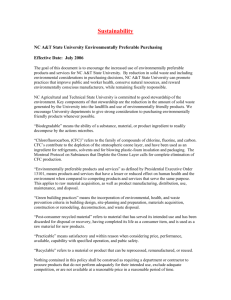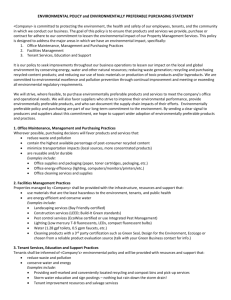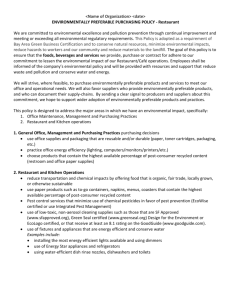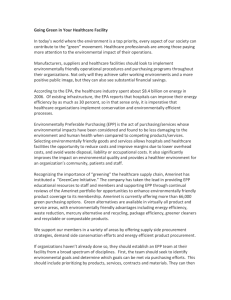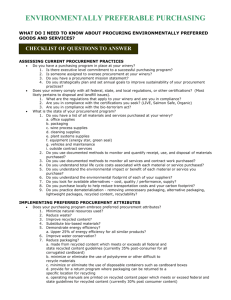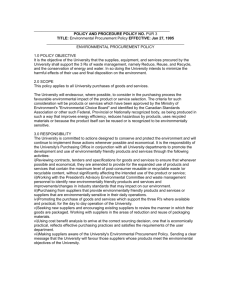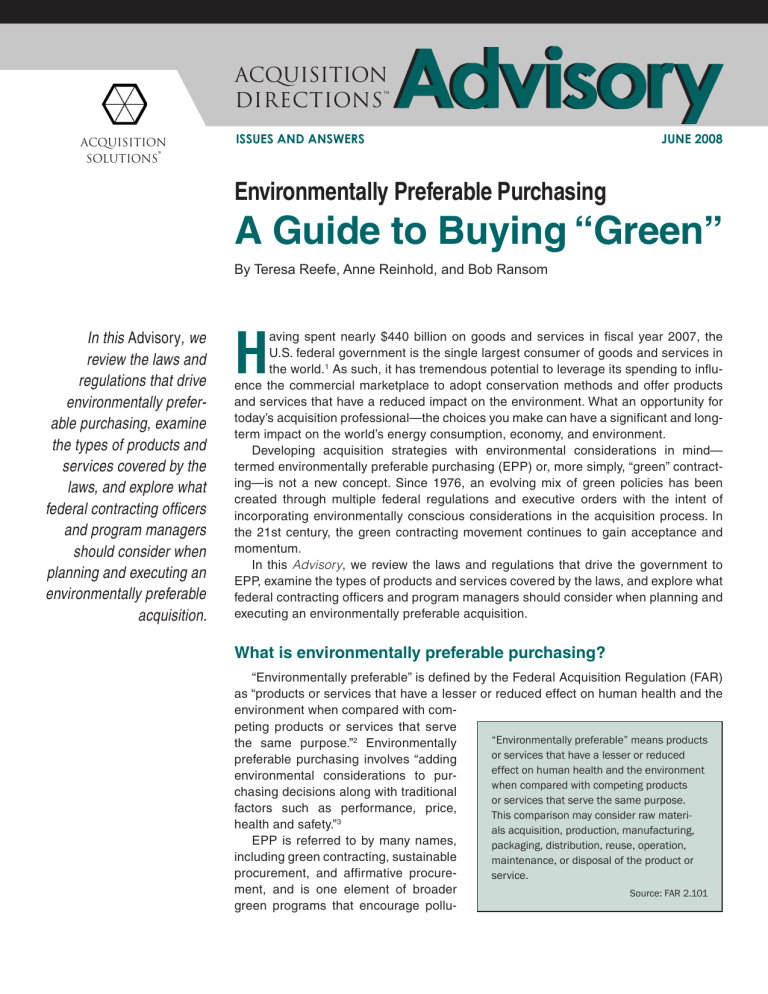
ACQUISITION
DIRECTIONS ™
ACQUISITION
SOLUTIONS®
ISSUES AND ANSWERS
JUNE 2008
Environmentally Preferable Purchasing
A Guide to Buying “Green”
By Teresa Reefe, Anne Reinhold, and Bob Ransom
In this Advisory, we
review the laws and
regulations that drive
environmentally preferable purchasing, examine
the types of products and
services covered by the
laws, and explore what
federal contracting officers
and program managers
should consider when
planning and executing an
environmentally preferable
acquisition.
H
aving spent nearly $440 billion on goods and services in fiscal year 2007, the
U.S. federal government is the single largest consumer of goods and services in
the world.1 As such, it has tremendous potential to leverage its spending to influence the commercial marketplace to adopt conservation methods and offer products
and services that have a reduced impact on the environment. What an opportunity for
today’s acquisition professional—the choices you make can have a significant and longterm impact on the world’s energy consumption, economy, and environment.
Developing acquisition strategies with environmental considerations in mind—
termed environmentally preferable purchasing (EPP) or, more simply, “green” contracting—is not a new concept. Since 1976, an evolving mix of green policies has been
created through multiple federal regulations and executive orders with the intent of
incorporating environmentally conscious considerations in the acquisition process. In
the 21st century, the green contracting movement continues to gain acceptance and
momentum.
In this Advisory, we review the laws and regulations that drive the government to
EPP, examine the types of products and services covered by the laws, and explore what
federal contracting officers and program managers should consider when planning and
executing an environmentally preferable acquisition.
What is environmentally preferable purchasing?
“Environmentally preferable” is defined by the Federal Acquisition Regulation (FAR)
as “products or services that have a lesser or reduced effect on human health and the
environment when compared with competing products or services that serve
“Environmentally preferable” means products
the same purpose.”2 Environmentally
or services that have a lesser or reduced
preferable purchasing involves “adding
effect on human health and the environment
environmental considerations to purwhen compared with competing products
chasing decisions along with traditional
or services that serve the same purpose.
factors such as performance, price,
This comparison may consider raw materihealth and safety.”3
als acquisition, production, manufacturing,
EPP is referred to by many names,
packaging, distribution, reuse, operation,
including green contracting, sustainable
maintenance, or disposal of the product or
procurement, and affirmative procureservice.
ment, and is one element of broader
Source: FAR 2.101
green programs that encourage pollu-
Advisory
tion and waste prevention, recycling, and energy and water use reduction.
Why are green programs and EPP
important to acquisition professionals?
Three reasons: it’s in the public interest, it makes good
business sense, and it’s the law. Certainly we all have a
responsibility to protect our environment. However, by the
sheer magnitude of the federal government’s purchasing
power, acquisition officials are in a unique position to lead
by example and implement their EPP responsibilities in a
manner that positively influences the marketplace toward
environmentally responsible actions.
As the government and industry adopt green programs
and implement EPP, the people and the planet benefit
through the conservation of natural resources, reduced
energy consumption and dependence on foreign oil, improved health and safety, decreased impact on our waste
stream, and stimulation of new markets. For example, as
the government increases its demand for recovered material products, manufacturers will attempt to meet those
demands. This creates jobs and economic opportunities.
As the use of recycled materials grows, the amount of
waste disposed of in landfills drops, and, ultimately, pollution caused by the extraction and processing of raw materials is reduced. This cause and effect has been termed
“closing the circle.”
Implementing green programs and making environmentally preferred purchasing part of an agency’s acquisition strategy also can make good business sense. A careful analysis of the full life-cycle costs of products—from
extracting and processing raw materials, to manufacturing, packaging, and transporting the product to the end
user, through disposal and replacement—shows that buying recycled, recyclable, and waste-reduced products can
save the government money in the long run. For example,
in 2007, the U.S. Postal Service won a “closing the circle”
award from the White House for implementing recycling
and pollution prevention programs that saved more than
$2 million in avoided landfill disposal costs and more than
$1 million from recycling undeliverable mail, cardboard,
plastic, and metals.4
The commercial sector also is realizing benefits from
incorporating green programs and EPP into its operating
practices. Dow Chemical is a good example of how industry is implementing green programs to improve its bottom
line. Between 1995 and 2005, Dow spent roughly $1 billion on refining its energy efficiency practices, investing in
new clean-tech technologies and working with manufac-
June 2008 turers on new green chemistry. According to Dow’s vice
president of sustainability, Neil Hawkins, the investment
subsequently paid off fivefold.5
Incorporating EPP into federal acquisition decisions
also is the law. Table 1 outlines the most prominent regulations that agency program managers and acquisition professionals should be aware of, many of which prescribe
agency-wide operating goals. When executing acquisitions for green products and services, contracting officers
are guided by subdivision 11.001(d) of the Federal Acquisition Regulation, which requires agencies to incorporate
energy-efficient, biobased, and environmentally preferable
purchasing requirements in all acquisitions of designated
green products or services, and part 23, which prescribes
the acquisition procedures and contract provisions that
should be incorporated into solicitations and contracts.
What policies and regulations drive green
contracting?
The major policies and regulations for EPP include
the Resource Conservation and Recovery Act (RCRA)
of 1976; Executive Order 13423, “Strengthening Federal
Environmental, Energy, and Transportation Management”;
Executive Order 13221, “Energy Efficient Standby Power
Devices,” and FAR part 23.6 FAR part 23 refers to many
acts and executive orders that implement our national energy policies. Table 1 summarizes these and other laws,
regulations, and executive orders that most directly pertain to green contracting.
To implement provisions of Executive Order 13423,
RCRA, and other related acts, the Office of Federal Procurement Policy (OFPP) is contemplating a revision to its
November 1992 Policy Letter 92-4, entitled “Procurement
of Environmentally Sound and Energy-Efficient Products
and Services.” In its December 28, 2007, Federal Register notice, OFPP sought comments on a proposed new
policy letter that, among other things, would require agencies to identify opportunities and give preference to the
acquisition of green products and services, consider mandatory and preferred sources to obtain green products
and services that meet their performance needs, implement automatic substitution policies for the purchase of
functionally equivalent green products and services, and
include requirements and preferences for the use of green
products in contracts. It also proposes to require the General Services Administration, Defense Logistics Agency,
and other central supply agencies to supply designated
green products and phase out any competing nongreen
products from their catalogs.7
ACQUISITION SOLUTIONS RESEAR CH INSTITUTE™
Advisory
Table 1: Laws, Executive Orders, and Regulations
Regulation, Law, or
Executive Order
Description/Purpose/Objective
Resource Conservation and
Recovery Act (RCRA) 1976
http://www.epa.gov/rcraonline/
The nation’s primary law governing the disposal of solid and hazardous waste. Set national goals to (1)
protect human health and the environment from potential hazards of waste disposal; (2) conserve energy and natural resources; and (3) ensure wastes are managed in an environmentally sound manner.
Also established a requirement for the Environmental Protection Agency to issue federal procurement
guidelines requiring the purchase of products containing recovered materials (buy-recycled program).
Farm Security and Rural Investment Act of 2002
http://www.ofee.gov/whats/archive/bbfarm.asp
Section 9002 established the biobased products purchasing program. Under the law, the U.S. Department of Agriculture (USDA) designates biobased products for agencies to purchase. Agencies are
required to establish affirmative procurement programs for purchasing the designated products and
to purchase the products with biobased content unless there is a price, performance, or availability reason not to do so. USDA also created a voluntary labeling program for biobased products.
Energy Policy Act of 2005
http://www.epa.gov/oust/fedlaws/publ_109-058.pdf
Section 104 directs agencies to purchase ENERGY STAR® and Federal Energy Management Program
(FEMP)-designated products when procuring energy-consuming products, except when it is not cost
effective or doesn’t meet functional requirements of the agency. Agencies also must incorporate energy-efficient specifications in procurement bids and evaluations and purchase only premium efficient
electric motors, air conditioning, and refrigeration equipment. It also instructs the General Services
Administration and Department of Defense to clearly identify and display ENERGY STAR® and FEMPdesignated products in any inventory, catalog, or product listing.
Clean Air Act (as amended)
http://www.epa.gov/air/caa/
Section 613 requires agencies to maximize the substitution of safe alternatives for ozone-depleting
substances.
Executive Orders 13101; 13123;
13134, as amended; 13148;
and 13149
Revoked by Executive Order 13423.
Executive Order 13423
http://ofee.gov/eo/eo13423_
main.asp
Defines eight conservation goals associated with the way agencies conduct environmental, energy,
and transportation management activities, These goals include a requirement to incorporate sustainable environmental practices into acquisitions of goods and services including biobased, environmentally preferable, energy-efficient, water-efficient, and recycled-content products and use paper of at
least 30 percent postconsumer fiber content. Agencies also are required to: reduce the quantity of
toxic and hazardous chemicals and materials acquired, used, or disposed of by the agency; ensure
new construction and major renovation of agency buildings comply with the 2006 memorandum of
understanding entitled “Federal Leadership in High Performance and Sustainable Buildings”8; reduce
the petroleum consumption of the agency’s fleet of vehicles; and ensure 95 percent of electronic
products purchased are Electronic Product Environmental Assessment Tool-registered. Agencies also
are required to improve energy efficiency and reduce greenhouse gas emissions; increase use of new
renewable energy sources; and reduce water consumption intensity.
Executive Order 13221
www.ofee.gov/eo/eo13221.pdf
Requires all federal agencies to buy products with low standby power.
Office of Federal Procurement
Policy Policy Letter 92-4
http://www.whitehouse.gov/
omb/procurement/policy_letters/92-4_110292.html
Requires executive agencies to consider energy conservation and efficiency factors in the procurement
of property and services, pursuant to the Energy Policy and Conservation Act, 42 U.S.C. 6201, et seq.;
section 3 of Executive Order 11912, as amended, and section 5 of Executive Order 12759. Stipulates
that executive agencies shall give preference in their procurement programs to practices and products
that conserve natural resources and protect the environment, pursuant to the Resource Conservation and Recovery Act as amended, 42 U.S.C. 6962, and Executive Order 12780, October 31, 1991.
Environmental factors will be considered, along with estimated costs and other relevant factors, in the
development of purchase requests, invitations for bids, and solicitations for offers
Federal Acquisition Regulation
(FAR) Part 11
http://www.acqnet.gov/far/current/html/Subpart%2011_1.html
Prescribes policies and procedures for describing agency needs for a prospective acquisition and
requires consideration of EPP products or services requirements outlined in part 23.
FAR Part 23
http://acquisition.gov/far/current/html/Subpart%2023_
1.html#wp1071602
Provides, among other things, the regulations and referenced clauses that apply to acquisitions of
EPP. There are several FAR clauses that are required to be included in solicitations and contracts
ACQUISITION SOLUTIONS RESEAR CH INSTITUTE™
June 2008
Advisory
Defense agencies already are required to maximize
green purchases. According to a 2004 memorandum issued by the acting under secretary for acquisition, technology, and logistics, defense agencies are required to
achieve “100 percent compliance” with federal laws and
executive orders requiring purchase of environmentally
friendly or green products and services “in all acquisition
transactions.”9
What are environmentally preferable
products and services?
Environmentally preferable products include recycled
and/or recovered content products, biobased products,
energy and renewable energy efficient products, water-
efficient products, alternative fuel vehicles and alternate
fuel, and alternatives to ozone-depleting compounds.
Environmentally preferable services include any service that requires the use of any of the aforementioned
products, as well as the effective handling of hazardous or
toxic chemicals. A simple example of an environmentally
preferable service acquisition would be a janitorial contract that requires the use of biobased cleaning products.
EPA, USDA, and DOE are responsible for designating
environmentally preferable products and services for federal agencies to acquire. A comprehensive list is included
in Table 2. When purchasing products and/or services,
agency officials should review the green components and
consult the Web sites listed to determine whether their
need could be met through one of the programs.
Table 2: Green Components and Responsible Agencies
“Green”
Component
Products and or Requirements
Responsible Agency and Duties
Recycled and/
or Recovered
content
products
Construction, landscaping, paper, park and recreation,
transportation, vehicular, and miscellaneous products
Environmental Protection Agency
Designates products under the Comprehensive Procurement Guidelines that contain recovered materials and
recommends practices for buying these products
http://www.epa.gov/epp/
Biobased
Products
Partial list includes: penetrating lubricants, hydraulic fluids
- mobile equipment, bedding, bed linens, and towels,
diesel fuel additives, roof coatings, water tank coatings,
hand cleaners and sanitizers, disposable containers, and
sorbents
U.S. Department of Agriculture
Develops and implements a program for designated biobased products (Federal Biobased Products Preferential
Purchasing Program - Biopreferred)
www.biobased.oce.usda.gov/
Energy-Efficient
Products
Appliances, heating and cooling, residential equipment,
office and commercial and industrial equipment, lighting,
commercial food services equipment, home envelope,
home electronics, other commercial products, and low
standby power equipment. EPEAT-registered products
include: computer desktops, laptops, and monitors.
Environmental Protection Agency & Department of Energy
Develop and maintain ENERGY STAR® specifications; Electronic Product Environmental Assessment Tool (EPEAT);
ENERGY STAR® 4.1 Program; Federal Energy Management
Program (FEMP)
www.energystar.gov
Water-Efficient
Products
Toilets, bathroom sink faucets, showerheads, landscape
irrigation services, weather-or sensor-based irrigation
control technologies
Environmental Protection Agency
WaterSense program promotes water efficiency and enhances the market for water-efficient products, programs,
and practices
http://www.epa.gov/watersense/
Alternative fuel
vehicles and
alternative fuel
Biodiesel, electricity, ethanol, hydrogen, methanol, natural
gas, propane; emerging alternative fuels under development: biobutanol, biogas, biomass to liquids, coal to liquids, fischer-tropsch diesel, gas to liquids, hydrogenationderived renewable diesel, P-Series, ultra-low sulfur diesel
Department of Energy
Provides wide range of information and resources for the
use of alternative fuels
http://www.eere.energy.gov/afdc/
Alternatives to
ozone-depleting compounds
Product alternatives for: refrigeration and air conditioning;
foam blowing agents; solvent cleaning; fire suppression
and explosion protection; aerosol solvents and propellants; sterilants; tobacco expansion; adhesives, coatings,
and inks
Environmental Protection Agency
Significant New Alternative Policy Program identifies alternatives to ozone-depleting substances and provides lists
of acceptable and unacceptable substitutes
http://www.epa.gov/ozone/snap/
June 2008 ACQUISITION SOLUTIONS RESEAR CH INSTITUTE™
Advisory
Figure 1:
Figure 1: Total Federal Spending
EPA Designated Products Per Fiscal Year
Is there a single organization that
provides overall direction for the federal
government’s sustainable practices?
Yes. The Office of the Federal Environmental Executive
(OFEE), created in 1993 by executive order, is responsible for “promoting sustainable environmental stewardship throughout the federal government.” OFEE provides
training to federal agencies on the requirements of Executive Order 13423 and acts as a centralized point for assistance and direction concerning sustainable practices.
OFEE’s vision is “a federal government that conducts its
environmental, transportation, and energy-related activities in support of agency missions in an environmentally,
economically, and fiscally sound, integrated, continuously
improving, efficient, and sustainable manner.”10
OFEE’s specific areas of focus fare:
• Encourage sustainable practices
• Identify and share success stories, best practices, and
other tools to make sustainable practices easier to adopt
and maintain
• Provide training, awareness, and outreach
• Assist in coordinating and advancing sustainability
policies across agencies
• Publicly advocate and support sustainable practices
and policies
• Measure and report on agencies’ progress (working
with the Office of Management and Budget on the scorecards)
While OFEE serves as the focal point for sustainable
practices, several federal agencies are responsible for implementing and maintaining various green programs. For
example, the Environmental Protection Agency (EPA) and
the U.S. Department of Agriculture (USDA) are responsible for promoting agency acquisition of recycled content
products, environmentally preferable, biobased products,
non-ozone-depleting substances, and products containing alternatives to certain priority chemicals. The Department of Energy (DOE) and EPA both assist agencies in
implementing energy-related purchasing requirements,
including alternative fuel vehicles.
How much is the federal government
spending on green products and
services?
A lot, and it’s growing each year. As illustrated in Figure
1, the federal government’s spending on green products
and services has increased steadily, from $7 billion in fiscal year 2003 to more than $40 billion in fiscal year 2007.
Source: Federal Procurement Data System – Next
Generation; as of May 2008
What does the FAR say regarding the
acquisition of environmentally preferable
products?
The Federal Acquisition Regulation provides a clear
mandate for acquiring environmentally preferred products
or services to the maximum extent practical. Specifically,
FAR 7.103 requires agency acquisition planners to “specify needs for printing and writing paper consistent with the
minimum content standards” and “comply with the policy
in 11.002(d) regarding procurement of biobased products,
products containing recovered materials, and environmentally preferable and energy-efficient products and services.”11 When defining requirements, FAR 11.002(d) stipulates that agencies shall consider maximum practicable
use of these products and services when (1) developing,
reviewing, or revising federal and military specifications,
product descriptions (including commercial item descriptions) and standards; (2) describing government requirements for products and services; and (3) developing
source selection factors. Finally, FAR part 23 prescribes
the acquisition policies and procedures for protecting and
improving the quality of the environment, including clauses and provisions that should be included in solicitations
and contracts for environmentally preferable products.
How can I define and incorporate
environmentally preferable purchasing
requirements into my solicitations and
contracts?
When preparing to purchase environmentally preferable products and services, we recommend an eight-step
process:
ACQUISITION SOLUTIONS RESEAR CH INSTITUTE™
June 2008
Advisory
“Green” Definitions
“Biobased product” means a product determined by the U.S. Department of Agriculture to be a commercial or industrial product (other
than food or feed) that is composed, in whole or in significant part, of biological products, including renewable domestic agricultural
materials (including plant, animal, and marine materials) or forestry materials.
“Energy-efficient product” means a product that (1) meets Department of Energy and Environmental Protection Agency criteria for use
of the Energy Star trademark label; or (2) is in the upper 25 percent of efficiency for all similar products as designated by the Department
of Energy’s Federal Energy Management Program. As used in this definition, the term “product” does not include any energy-consuming
product or system designed or procured for combat or combat-related missions.
“Energy-efficient standby power devices” means products that use (1) external standby power devices or that contain an internal
standby power function; and (2) no more than one watt of electricity in their standby power consuming mode or meet recommended low
standby levels as designated by the Department of Energy Federal Energy Management Program.
“Energy-savings performance contract” means a contract that requires the contractor to (1) perform services for the design, acquisition, financing, installation, testing, operation, and where appropriate, maintenance and repair of an identified energy conservation
measure or series of measures at one or more locations; (2) incur the costs of implementing the energy savings measures, including
at least the cost (if any) incurred in making energy audits, acquiring and installing equipment, and training personnel in exchange for a
predetermined share of the value of the energy savings directly resulting from implementation of such measures during the term of the
contract; and (3) guarantee future energy and cost savings to the government.
“Environmentally preferable” means products or services that have a lesser or reduced effect on human health and the environment
when compared with competing products or services that serve the same purpose. This comparison may consider raw materials acquisition, production, manufacturing, packaging, distribution, reuse, operation, maintenance, or disposal of the product or service.
“Recovered material” means waste materials and by-products recovered or diverted from solid waste, but the term does not include
those materials and by-products generated from, and commonly reused within, an original manufacturing process.
Source: FAR 2.101
• Step 1 – Determine if your requirement is for a designated environmentally preferred product or for a service
that may require the use of a designated EPP product.
Start with the information in Table 2 to learn about the
various programs managed by EPA, USDA, and DOE,
and use information on their respective Web sites to make
this determination.
• Step 2 – Conduct market research. Market research is
critical in determining the type and extent of “green” products available in the commercial marketplace. Knowing
that the world’s largest consumer desires green products,
many vendors already list their biobased and postconsumer waste content and energy conservation features,
including ENERGY STAR®-designated products.
• Step 3 – Describe the need with specific environmentally preferred requirements. By visiting EPA’s EPP program Web site at http://www.epa.gov/oppt/epp/pubs/about/
about.htm, agency officials can find and evaluate sample
specifications and performance requirements.12 Also consider information in your agency’s Environmental Management System, which defines the basic management
framework and approach for addressing environmental
June 2008 aspects of the agency’s internal operations, and its Affirmative Procurement Program, which defines the agency’s
strategy for maximizing the purchase and use of EPA and
USDA designated items.13 Agencies are required to prepare and maintain these plans as prescribed by Executive
Order 13423 and section 6002 of RCRA respectively.
• Step 4 – Prepare an independent cost estimate that
considers total life-cycle costs when evaluating the cost
effectiveness of environmentally preferred alternatives.
EPA’s EPP Web site contains a set of useful tools to calculate costs and benefits of federal purchasing choices.14
Exceptions to purchasing designated environmentally
preferred products should be documented and approved
by the agency head as prescribed by FAR part 23 and retained in the contract file. These exceptions also must be
identified when reporting the award in Federal Procurement Data System–Next Generation (FPDS-NG).
• Step 5 – Prepare the solicitation with environmentally preferred-related provisions. Federal contracting officers should consult FAR part 23 to identify solicitation
and contractual requirements for acquiring environmentally preferred products and services. Contracting officers
ACQUISITION SOLUTIONS RESEAR CH INSTITUTE™
Advisory
also may define evaluation factors that encourage efforts
to meet and exceed specified environmentally preferred
requirements. A summary of the solicitation and contract
clauses prescribed by FAR part 23 is set forth in Table 3.
In addition to these, and in the absence of agency-specific
supplemental provisions, contracting officers may consider the sample contract language posted on the EPA’s EPP
program Web site.
Table 3: FAR Part 23 Provisions and Clauses (Updated through FAC 2005-26)
Clause
Prescription
52.223-1 Biobased Product Certification
Insert in solicitations that (1) require the use of USDA-designated items; or (2) include the
clause 52.223-2.
Insert in service or construction solicitations and contracts unless the contract will not involve
the use of USDA-designated items at http://www.usda.gov/biopreferred.
52.223-2 Affirmative Procurement of
Biobased Products Under Service and
Construction Contracts
52.223-3 Hazardous Material Identification and Material Safety Data
52.223-4 Recovered Material
Certification
52.223-5 Pollution Prevention and Rightto-Know Information
52.223-7 Notice of Radioactive
Materials
52.223-9 Estimate of Percentage of
Recovered Material Content for EPADesignated Items
52.223-10 Waste Reduction Program
52.223-11 Ozone-Depleting Substances
52.223-12 Refrigeration Equipment and
Air Conditioners
52.223-13 Certification of Toxic
Chemical Release Reporting
52.223-14 Toxic Chemical Release
Reporting
52.223-15 Energy Efficiency in EnergyConsuming Products
52.223-16 IEEE 1680 Standard for the
Environmental Assessment of Personal
Computer Products
52.223-17 Affirmative Procurement of
EPA-designated Items in Service and
Construction Contracts
Insert in solicitations and contracts if the contract will require the delivery or hazardous materials as defined in 23.301
Insert in solicitations that: (1) Require the delivery or specify the use of EPA-designated items;
or (2) Include the clause at 52.223-17.
Insert in solicitations and contracts that provide for performance, in whole or part, on a federal
facility.
Insert in solicitations and contracts for supplies that are or that contain (1) radioactive material requiring specific licensing under regulations issued pursuant to the Atomic Energy Act
of 1954; or (2) radioactive material not requiring specific licensing in which the specific activity
is greater than 0.002 microcuries per gram or the activity per item equals or exceeds 0.01
microcuries. Such supplies include, but are not limited to, aircraft, ammunition, missiles, vehicles, electronic tubes, instrument panel gauges, compasses, and identification markers.
Insert in solicitations and contracts exceeding $100,000 that are for, or specify the use of,
EPA-designated items containing recovered materials. If technical personnel advise that estimates can be verified, use the clause with its Alternate I.
Insert in all solicitations and contracts for contractor operation of government-owned or
-leased facilities and all solicitations and contracts for support services at government-owned
or -operated facilities.
Insert in solicitations and contracts for ozone-depleting substances or for supplies that may
contain or be manufactured with ozone-depleting substances.
Insert in solicitations and contracts for services when the contract includes the maintenance,
repair, or disposal of any equipment or appliance using ozone-depleting substances as a refrigerant, such as air conditioners, including motor vehicles, refrigerators, chillers, or freezers.
Insert in all solicitations for competitive contracts expected to exceed $100,000 and competitive 8(a) contracts, unless it has been determined in accordance with 23.905(b) that to do so
is not practicable.
Insert in competitively awarded contracts exceeding $100,000 and competitively awarded 8(a)
contracts, except when the determination at 23.905(b) has been made.
Insert in solicitations and contracts when energy-consuming products listed in the ENERGY
STAR® Program or FEMP will be (1) delivered; (2) acquired by the contractor for use in performing services at a federally controlled facility; (3) furnished by the contractor for use by
the government; or (4) specified in the design of a building or work, or incorporated during its
construction, renovation, or maintenance.
Insert in all solicitations and contracts for (1) personal computer products; (2) services that
require furnishing of personal computer products for use by the government; or (3) contractor operation of government-owned facilities. Agencies may use the clause with its Alternate I
when there are sufficient EPEAT Silver registered products available to meet agency needs.
Insert in service or construction solicitations and contracts unless the contract will not involve
the use of EPA-designated items.
ACQUISITION SOLUTIONS RESEAR CH INSTITUTE™
June 2008
Advisory
• Step 6 – Evaluate offers. Consider the vendor’s plans
to comply with and exceed the defined environmentally
preferred requirements.
• Step 7 – Report the award in the Federal Procurement
Data System–Next Generation (FPDS-NG). Include conditions for any appropriately approved exceptions to purchasing designated environmentally preferred products.
• Step 8 – Monitor implementation. Ensure postaward
contract administration plans, actions, and communications affirm EPP requirements and validate that products
delivered are consistent with the contract’s EPP energy
savings, biobased, and postconsumer waste content requirements prior to acceptance and payment.
What are the responsibilities of persons
implementing EPP actions?
Senior agency officials and program and contracting office personnel all have a role in planning and implementing
EPP. Table 4 summarizes their respective responsibilities.
Are there any samples of “green”
contract language that can be used in
solicitations and contracts?
Yes. EPA’s EPP program Web site at http://www.epa.
gov/epp/ contains a database of sample contracts and
provisions used to acquire green products and services.
This includes sample provisions for acquiring biobased
and recycled content products, as well as electronic products when the EPEAT rating is required. EPA also has
partnered with OFEE and the Whole Building Design
Guide to develop a Federal Green Construction Guide for
Specifiers that provides sample specification language for
construction products and services.15
OFEE has developed sample biobased language that
can be inserted into different types of contract statements
of work.16 The samples include product use templates for
custodial operations, grounds maintenance, minor construction contracts, operations and maintenance contracts, and vehicle maintenance contracts.
Table 4: Responsibilities
Preaward
Responsibilities
Agency
Program Office
Contracting Office
•
•
•
Develop an Environmental Management System
(EMS) to define the basic
management framework
and approach for addressing environmental aspects
of internal agency operations.
•
Establish an Affirmative
Procurement Program (APP)
which forms the strategy for
maximizing the purchase
and use of EPA and USDA
designated items.17
Postaward
Responsibilities
•
Promote and monitor green programs and
affirmative procurement
activities, and report status
to the Office of Management and Budget18
June 2008 Consult the agency’s APP to identify EP
acquisition strategies.
•
Perform market research to identify
availability of EP products and services.
This includes reviewing green components
programs listed in Table 2.
•
Consider total life-cycle costs when
developing Independent Cost Estimates
to determine the cost effectiveness of EP
alternatives.
•
Define product or service needs to
reflect EPP requirements as prescribed by
FAR 11.002(d) and 23.
•
Monitor post-award contract actions
relative to EPP requirements.
•
Validate products delivered are consistent with EPP energy savings, biobased
and post-consumer waste content requirements prior to acceptance and payment.
Review acquisition plans and procurement requests to determine if EP
products or services are needed using
information in Table 2.
• Validate that EPP requirements are
defined as required by FAR Part 11 and
23 and agency-specific policies.
• Maintain documentation of EPPrelated decisions in the contract file
including estimates, certifications, and if
necessary, as required by FAR 23.405,
justifications for acquisitions above the
micro-purchase threshold that describes
why an EPA designated product containing recovered materials will not be
purchased;
• Insert applicable clauses in solicitations and contracts as prescribed by FAR
Part 23 (see Table 3);
• Include responsiveness to EPP
requirements and objectives as an evaluation criteria
•
Ensure post-award contract administration plans, actions and communications affirm EPP requirements.
ACQUISITION SOLUTIONS RESEAR CH INSTITUTE™
Advisory
The DOE ENERGY STAR® program provides sample
procurement language for a variety of products and services that are required to meet federal ENERGY STAR®
standards.19
The Department of the Interior has a sample with model language for Section L of a solicitation that includes
mandatory as well as preferable attributes for a cleaning
contract.20
Also, the EPEAT Web site contains sample language
taken from solicitations for electronic products that include
environmental criteria.21
How can I stay “green” when shopping
online and with my government credit
card?
The EPA’s Web site has some great tips for buying green
with the government credit card.22 In accordance with FAR
subpart 13.201, even when making micropurchases with
your government credit card you must consider designated environmental preference products. To help federal
buyers easily identify products that contain environmental
attributes, an environmental specialty category has been
added to GSA Advantage!® online shopping service. Also,
an Environmental Specialty Category has been added to
the GSA Advantage!® online shopping service.23 This new
category allows federal buyers direct access to a listing of
products that contain environmental attributes, including
recycled and energy-efficient products. GSA Advantage!®
identifies green products with 13 different symbols, including the EPA/DOE ENERGY STAR® label, FEMP energy
efficient items symbol, EPEAT-registered symbol, and the
recycling (chasing arrows) symbol.
What reporting requirements are
associated with EPP?
Agencies are required to report in FPDS-NG purchases of EPA-designated items that are delivered or used in
the performance of a contract. The requirement to code
EPA-designated products in FPDS-NG applies not only
to the purchase of a product, but also to services that require the use of EPA-designated products. For example,
a grounds maintenance contractor may be required to
purchase EPA-designated landscaping products. The purchase of those products would be required to be captured
in FPDS-NG.
As prescribed by section 6002 of RCRA and section
9002 of the Farm Security and Rural Investment Act,
OFPP must report to Congress every two years on actions taken by federal agencies to implement the respective statutes. The Federal Environmental Executive also
is required to report to the President every two years on
agency implementation of Executive Order 13423, including recycling and green purchasing activities. In addition,
Executive Order 13423 requires agencies to collect, analyze, and report to the President information to measure
implementation of the order. The Office of Management
and Budget (OMB) and the Office of the Federal Environmental Executive also use the annual reporting data to
evaluate agency progress for the green purchasing standard for success on the OMB Scorecard on Environmental Stewardship.24 For FY2007 reporting purposes, OFPP
and OFEE developed a joint survey to collect information
to meet the reporting requirements of RCRA and the Farm
Security and Rural Investment Act, as well as several requirements of Executive Order 13423.25
Where can I obtain training on green
purchasing?
There are several options for obtaining training on
green contracting. The Office of Personnel Management’s
GoLearn offers a Web-based course entitled “What Is
Green Purchasing, Anyway?”26 This course is intended
for contracting personnel, purchase card holders, facilities managers, and fleet managers and provides an introduction to the federal green purchasing program. It is
designed in modules and can be used both for introductory and refresher training.
OFEE offers classroom-style green purchasing training to agency contracting, environmental, and facilities
staff that addresses each component of the federal green
purchasing program, with more in-depth training on purchasing ENERGY STAR®, energy-efficient, and biobased
products.27
OFEE and the U.S. Army Center for Health Promotion and Preventive Medicine have developed a green
purchasing train-the-trainer program, which has been
presented to more than 30 agency environmental and
procurement staff. In addition to addressing the units dis-
ACQUISITION SOLUTIONS RESEAR CH INSTITUTE™
June 2008
Advisory
cussed in OFEE’s green purchasing training, the PowerPoint presentation and accompanying script cover the
types of training to provide to different audiences, compliance, program implementation, and goals and metrics.
Conclusion
Mandated by a vast array of laws and executive orders,
green programs and environmentally preferable purchasing are starting to gain momentum among federal acquisition professionals and helping agencies realize reduced
operating costs while also being good stewards of the environment. Nevertheless, acquisition professionals must
navigate programs managed by EPA, USDA, and DOE
to understand and identify all of the designated environmentally preferable products, including recycled and/or
recovered content products, biobased products, energy
and renewable energy efficient products, water-efficient
products, alternative fuel vehicles and alternate fuel, and
alternatives to ozone-depleting compounds.
With more than $40 billion in environmentally preferred
purchases reported in FY2007, federal agencies are starting to understand and implement green acquisition practices with increasing regularity. In the end, the growing interest in environmentally preferable purchasing, regardless of
whether it is mandated by law or not, clearly demonstrates
our collective recognition that when it comes to conservation and preserving our environment, everyone wins.
♦
Endnotes
1
Federal Procurement Data System-Next Generation data, extracted February 25, 2008.
2 Federal Acquisition Regulation 2.101, “Definitions,” and the U.S. Environmental Protection Agency Environmentally Preferable Purchasing Web site:
http://www.epa.gov/epp/index.htm.
3
Environmental Protection Agency: http:/www.epa.gov/epp/pub/about/faq.htm.
4 The “Closing the Circle” award irecognizes outstanding achievements of federal employees and their facilities for efforts that resulted in significant
contributions to, or have made a significant impact on, promoting environmental stewardship; http://ofee.gov/ctc/ctc.asp. USDA’s 2008 Center’s “Closing
the Circle” Awards: http://64.233.169.104/search?q=cache:xr9EAvPdA-4J:www.ofee.gov/whats/08CTC_winners_20080610.pdf.
5
Stefanie Olsen, “Dow Chemical’s green-meets-green vision,” May 2008; http://news.cnet.com/8301-11128_3-9948558-54.html.
6 The Resource Conservation and Recovery Act of 1976; http://www.epa.gov/epaoswer/osw/laws-reg.htm#regs; Executive Order (EO) 13423, “Strengthening Federal Environmental, Energy, and Transportation Management,”; http://www.whitehouse.gov/news/releases/2007/01/20070124-2.html; Executive
Order 13221, “Energy Efficient Standby Power Devices”; http://www.epa.gov/fedrgstr/EPA-WASTE/2007/December/Day-28/f25211.htm.
7 Office of Management and Budget, Office of Federal Procurement Policy; “Acquisition of Green Products and Services,” (December 28, 2007) As
published in the Federal Register; http://www.ofee.gov/gp/20071228_OFPPpolicy_FARproposal.pdf.
8 The Federal Leadership in High Performance and Sustainable Buildings Memorandum of Understandings; http://www.fedcenter.gov/_kd/Items/actions.cfm?action=Show&item_id=4713&destination=ShowItem.
9 “Establishment of the DOD Green Procurement Program (GPP),” memorandum, Under Secretary of Defense for Acquisition, Technology, and Logistics, August 27, 2004; www.acq.osd.mil/dpap/Docs/policy/greenprocurement/GPP%20Strategy%2009082004.doc.
10 Office of the Federal Environmental Executive; Vision Statement; Accessed in June 2008; http://ofee.gov/about/modified.asp#priorities.
11 Federal Acquisition Regulation Section 7.103. http://www.acqnet.gov/far/current/html/Subpart%207_1.html#wp1098043.
12 The EPA’s Environmentally Preferable Purchasing website; http://www.epa.gov/epp/pubs/about/about.htm.
13 Executive Order 13148, “Greening the Government Through Leadership in Environmental Management,” requires each federal agency to develop
and implement an EMS at its locations by December 31, 2005. An EMS is a framework that allows an organization to consistently address the effects its
operations may have on the environment.
14 Environmental Protection Agency; Environmentally Preferable Purchasing Web site accessed in May 2008; http://www.epa.gov/epp/pubs/about/about.
htm.
15 Federal Green Construction Guide for Specifiers; http://www.wbdg.org/design/greenspec_msl.php?s=001000.
16 Under Contract/Procurement Language at: http://www.fedcenter.gov/programs/buygreen/#tools.
17 Resource Conservation and Recovery Act (1976) Section 6002.
18 Resource Conservation and Recovery Act (1976) Section 6002; and Farm Security and Rural Investment Act, Section 9002.
19 Under Sample Procurement Language at: http://www.energystar.gov/index.cfm?c=bulk_purchasing.bus_purchasing.
20 Department of the Interior. Accessed, May 2008; Sample section L available at: www.doi.gov/greening/sustain/clean_secL.doc.
21
Electronic Product Environmental Assessment Tool, EPEAT Purchasers and RFPs; http://www.epeat.net/RFP.aspx.
22 Tips for Buying “Green” with the Government Credit Card; http://www.epa.gov/epp/tools/creditcard.htm.
10
June 2008 ACQUISITION SOLUTIONS RESEAR CH INSTITUTE™
Advisory
23 General Services Administration: “Go Environmental with GSA Advantage”; https://www.gsaadvantage.gov/advgsa/advantage/search/specialCategory.do?cat=ADV.ENV.
24 “FY 2007 Reporting on Implementation of the Resource Conservation and Recovery Act, Section 6002, the Farm Security and Rural Investment
Act, Section 9002, and Other Environmental Purchasing Requirements,” memorandum, Office of Federal Procurement Policy, November 1, 2007;
http://64.233.169.104/search?q=cache:dSK8mWimJsAJ:www.whitehouse.gov/omb/procurement/memo/data_call_transmittal_2007.pdf+Section+6002+o
f+the+RCRA+and+section+9002+of+the+FSRIA&hl=en&ct=clnk&cd=1&gl=us.
25 “FY 2007 Reporting on Implementation of the Resource Conservation and Recovery Act, Section 6002, the Farm Security and Rural Investment
Act, Section 9002, and Other Environmental Purchasing Requirements,” memorandum, Office of Federal Procurement Policy, November 1, 2007;
http://64.233.169.104/search?q=cache:dSK8mWimJsAJ:www.whitehouse.gov/omb/procurement/memo/data_call_transmittal_2007.pdf+Section+6002+o
f+the+RCRA+and+section+9002+of+the+FSRIA&hl=en&ct=clnk&cd=1&gl=us.
26 GoLearn.gov Learning Center Course Catalog, Accessed in May 2008 at http://www.golearn.gov/CourseCatalog/index.cfm?fuseaction=oltoverview&
intCourseID=5951&AddPopularity=1.
27
Office of the Federal Environmental Executive Green Purchasing Training. Accessed in May 2008 at http://ofee.gov/gp/training.asp.
The Advisory is published monthly as part of the Virtual Acquisition Office™ subscription service, made available by Acquisition Solutions, Inc., 1655 North Fort Myer Drive, Suite 1000, Arlington, Virginia 22209, 703-253-6300, fax 703-253-6301,
www. acquisitionsolutions.com. Information and opinions are based on best available information, but their accuracy and
completeness cannot be guaranteed. Layout by Julie Olver. Contents ©2008 by Acquisition Solutions, Inc. All rights reserved.
Single copies and volume discounts are available from Acquisition Solutions, Inc.
ACQUISITION SOLUTIONS RESEAR CH INSTITUTE™
June 2008
11


